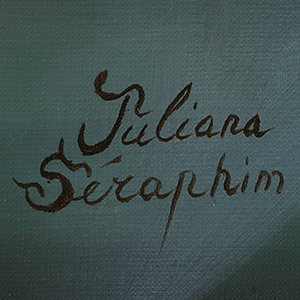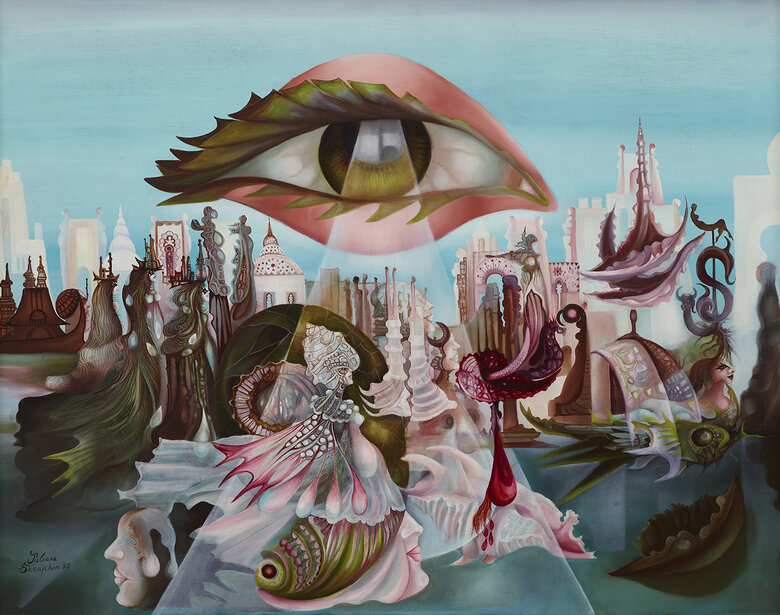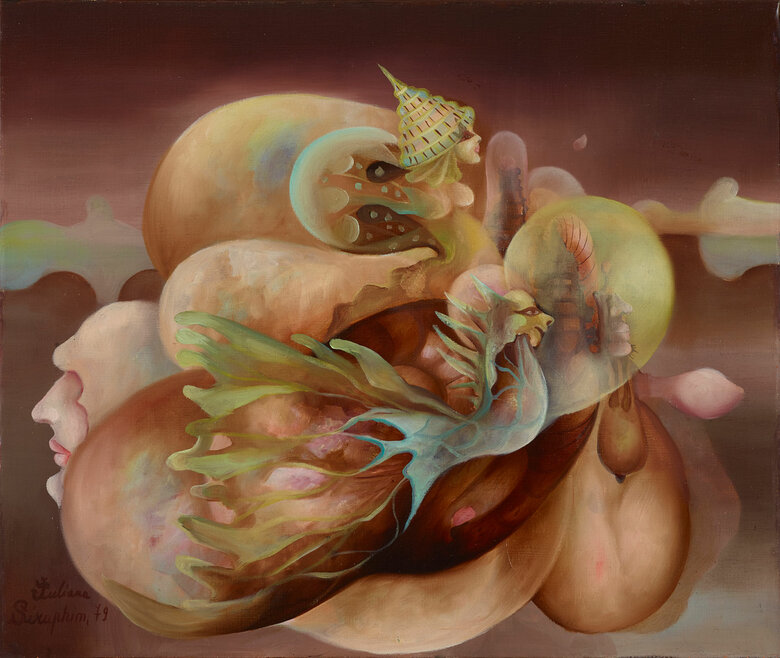Juliana Seraphim was born in Jaffa, Palestine, in 1934. Following the Palestinian Nakba, she fled with her family to Sidon, Lebanon by boat in 1949, and four years later, faced with the...


JULIANA SERAPHIM, Palestine (1934 - 2005)
Bio
Written by L'Or Iman Puymartin & Christine Labban
Juliana Seraphim was born in Jaffa, Palestine, in 1934. Following the Palestinian Nakba, she fled with her family to Sidon, Lebanon by boat in 1949, and four years later, faced with the impossibility of returning home, they moved to Beirut. In the Lebanese capital, Seraphim worked in the UNRWA headquarters as a secretary before leaving Lebanon to complete her education in the arts. She studied at the Academies of Fine Arts in Florence and Paris, as well as the Royal Academy of San Fernando in Madrid.
Beirut’s cultural golden age was in full bloom when Seraphim arrived in the city. Music, theater, cinema, and the visual arts flourished, and a vibrant international intellectual culture was growing at a rapid pace. Unlike most Palestinian refugees, Seraphim and her family were able to attain Lebanese citizenship, and the artist was lucky to benefit from experiences her countrymen in the camps could not access. After secondary school, Seraphim did not enroll in university, but maintained a busy work schedule; fortunately, she was able to pursue her passion for art through lessons with painter Jean Khalife after work hours. Her first exposure to Beirut’s art world came through subsequent exhibitions at Khalife’s studio in the 1950s. In the late ’50s, she spent a year in Florence, followed by a year in Madrid, which was a very formative period for the artist. In Madrid, she met art critic Carlos Ariane, who suggested that India ink was the medium best suited to translate Seraphim’s surreal imagination into the dreamlike compositions she strove to create. After participating in several exhibitions both locally and internationally, Juliana exhibited in the hotly anticipated inaugural Salon d’Automne at the Sursock Museum in 1961. This exhibition marked the beginning of Seraphim’s career as a professional artist.
Just fourteen years old, when Zionist forces conquered Palestine, Juliana Seraphim was part of the first generation of Palestinian artists whose practices evolved in exile. While she derived inspiration from her homeland –particularly her grandfather’s home in Jerusalem and the seascapes she grew up observing in Jaffa– she did not make art that directly addressed the politics of Palestinian liberation. This choice distinguished her from what the late Palestinian artist and art historian Kamal Boullata calls the “camp artists,” i.e., a group of male, often self-taught artists that coalesced in the refugee camps around the nascent Palestinian Liberation Organization. Because of her family’s citizenship status, she had access to Beirut’s art world in ways that the camp artists didn’t, as well as the all-important ability to travel throughout the globe. She was primarily considered an outsider by the more politically active Palestinian contingent in Beirut because she created surreal and fantastical art instead of focusing on the Palestinian national cause.
Seraphim’s signature style was a loose form of surrealism that allowed her to express her imagination in a free-flowing, dreamlike way as if peering into her own subconscious. Her work was influenced by her life in a city where topics of feminism and female sexuality were being discussed by Beirutis and foreign expats alike. She lived in a time where spirituality, exploration of alternative forms, and fighting for freedom—especially women’s rights—were central to social, political, and artistic movements, and these elements are reflected in her work’s central motifs. Magical architecture, mystical flowers, and the (often sexualized) female body are recurring figures in both her paintings and her ink drawings. Outlandish cityscapes consisting of spirals, dendritic towers, lacy ornaments, and pointed arches convey a sense of mystery, constructing elusive but entrancing utopias. Her women morph into flowers and vice versa, begging meditation on the complexity and delicacy of the female physical and emotional being. While many of her paintings carry a sensual undertone, the vision in her drawings is often more explicit –in fact, some of her ink drawings are unabashedly erotic, though the artist coyly denied intending them to read in such direction. Though women dominate these scenes too, males and androgynous figures also enter the fray, sometimes even represented as the domineering center of by sharper-edged cities with little place for the delicate “fleur” characters.
Seraphim often likened the female’s emotional complexity to a flower’s fragility, but she herself was no shrinking violet. Remembered as a bon vivant as well as a fiercely independent individual, she never married; as her friend and fellow artist Helen Khal recalls in The Woman Artist in Lebanon (1987), she felt that “the woman was too complicated and the artist too independent” to settle down with a husband. Indeed, her work’s emphasis on the female form –and its exploration of liberated female sexuality– shows the artist’s investment in eroding gender norms and the power structures they perpetuate. Her bizarre, often garishly colored paintings and dense, highly detailed drawings seem to call forth Seraphim’s own version of utopia: a world where femininity and sensitivity are widespread and celebrated, overpowering the coarse-edged male presence.
Juliana Seraphim lived as a professional artist between Paris and Beirut until she passed away in 2005.
Sources
Abillama, Nour Salamé, and Marie Tomb. Art From Lebanon. Vol. 1. Beirut, Lebanon: Wonderful editions, 2012.
Boullata, Kamal. "Pioneering Women in Palestinian Art." Accessed October 17, 2017. http://www.hagar-gallery.com/Catalogues/Self_Portrait_02_01.pdf.
Khal, Helen. The Woman Artist in Lebanon. 1987: Institute for Women's Studies in the Arab World.
Mattar, Philip. The Encyclopedia of the Palestinians. New York City, New York: Facts on File, Inc, 2005.
CV
Selected Solo Exhibitions
2016
Twenty Years and Beyond, Noah's Ark Art Gallery, Beirut Lebanon
1993
Station des Arts Gallery, Beirut, Lebanon
1992
Station des Arts Gallery, Beirut, Lebanon
1991
Hotel Chahba-Cham Art Gallery, Damascus, Syria
1990
Khayal Gallery, Ehden, Lebanon
1989
Amadis Art Gallery, Madrid, Spain
1988
Galerie La Toile – Rimal, Beirut, Lebanon
1987
Galerie La Toile – Rimal, Beirut, Lebanon
1985
Galerie Art 3, Paris, France
1983
Suzanne Ponds Art Gallery, Cannes, France
1983
Galerie Bekhazi (GAB Center), Beirut, Lebanon
1980
Jordan National Gallery of Fine Arts, Amman, Jordan
Alef Art Gallery, Kuwait
Galerie Bekhazi (GAB Center), Beirut, Lebanon
1979
Galerie Art 3, Paris, France
1978
X Art Gallery, Paris, France
1977
Tabet Art Gallery, Paris, France
1975
Brigitte Shehadeh Gallery, Beirut, Lebanon
1971
Samir Nassif Art Gallery, Beirut, Lebanon
1969
Cassia Art Gallery, Beirut, Lebanon
1967
Galerie Journal L’Orient, Beirut, Lebanon
1965
Galerie Journal L’Orient, Beirut, Lebanon
1964
Elie Garzouzi Gallery, Beirut, Lebanon
1961
La Licorne Art Gallery, Beirut, Lebanon
1960
International Art Gallery, Florence, Italy
Selected Group Exhibitions
2025
Nadia Saikali & Her Contemporaries, Maraya Art Centre, Sharjah, UAE
Women's Agency in Arab Art: Kinship, Education, and Political Activism, Lebanese American University, Beirut, Lebanon
2024
Arab Presences: Modern Art and Decolonisation: Paris 1908-1988, Musee D'Art Moderne de Paris, Paris, France
Butterfly Time: Part I, Richard Saltoun, New York City, USA
Prints and Printmaking, Dalloul Art Foundation, Beirut, Lebanon
The 14th Floor, Gratin, New York City, United States
2023
Manifesto of Fragility: Beirut and The Golden Sixties, Mathaf, Arab Museum of Modern Art, Doha, Qatar
Partisans of Nude: An Arab Art Genre in an Era of Contest, 1920-1960, Wallach Art Gallery, Columbia University, Harlem, New York, USA
UNTITLED Abstractions, Dalloul Art Foundation (DAF), Beirut, Lebanon
2022
The Douche, Seraphim & Barrage: A Search For The Fantastic, Agial Art Gallery, Beirut, Lebanon
Taking Shape: Abstraction from the Arab World, 1950s-1980s, The Block Museum, Evanston, Chicago, Illinois, USA
Manifesto of Fragility: Beirut and The Golden Sixties, Lyon Museum of Contemporary Art, Lyon, France
2021
Zaat: Collectors Eye, Fann A Porter, Dubai, United Arab Emirates
2019
(Nothing But) Flowers, Saleh Barakat Gallery, Beirut, Lebanon
2016
Lebanon Modern, Les artistes femmes au Liban, curated by Pascal Odile, At the Beirut Art Fair, Lebanon
2013
Tajreed, CAP Kuwait, Kuwait
2012
Art From Lebanon, Beirut Exhibition Center, Beirut, Lebanon
1997
Salon D’Automne, Sursock Museum, Beirut, Lebanon
1996
Fine Arts Museum, Sharjah, UAE
1995
Al-Majlis Gallery, Dubai, UAE
Intercontinental Hotel, Bahrain
Salon du Printemps, Beirut, Lebanon
National Museum of Kuwait
1980
Belvedere Museum,Tunis, Tunisia
1978
Museum of Neuilly, Paris, France
1975
Heirlooms Gallery, Alabama, USA
1971
Imperial Museum of Tokyo, Japan
Bibliothèque Nationale, Paris, France (exhibited with Picasso and Dalì)
1969
First National City Bank, Beirut, Lebanon Smithsonian Institution,Washington D.C., USA
1968
Gallery Motte, Paris, France (exhibited with painters Dubuffet, Kaimakoff, and Luc Simon)
1967
Chenilis Gallery, London, UK
1965
Sao Paulo Biennale, Brazil
1963
Paris Biennale, France
1962
Alexandria Biennale, Egypt
Barcaccia Gallery, Rome, Italy
1961
Nicolas Sursock Museum, Lebanon
Awards and Honors
The Florence Prize, Italy
The Prize of the Ministry of National Education, Lebanon
The Second Prize for Foreigners at the City of Viarregio, Italy
Collections
The MET, New York, USA
Museum of the City of Viarregio, Italy
Museum of "La Femme Célèbre", Neuilly Paris, France
Musée du suréalisme, Paris, France
Institut du Monda Arabe, Paris, France
Jordan National Gallery of Fine Arts, Amman, Jordan
Nicolas Sursock Museum, Beirut, Lebanon
Ramzi and Saeda Dalloul Art Foundation, Beirut, Lebanon
The collection of the Ministry of Culture, Beirut, Lebanon
Barjeel Art Foundation, Sharjah, UAE
Documents
Palestinian Visual Art (II) Pathfinders (1955-1965) rom Kamal Boullata’s entry ”Art” in Philip Mattar, ed. The Encyclopedia of the Palestinians
Kamal Boullata
New York: Facts on File, English, 2005
Highlight from Book
"The World, the Self, and the Body: Pioneering Women in Palestinian Art"
Kamal Boullata
SAQI, English
Excerpt from book p.167-178
"العالم والذات والجسد: رائدات في الفن الفلسطيني"
Kamal Boullata
SAQI, Arabic/Hebrew
Excerpt from book p.9-22
Palestinian Art
Gannit Ankori
Reaktion Books LTD/DAF Library, English, 2006
Excerpt from book p.99-100
Art From Lebanon Modern and Contemporary Artists 1880-1975 Volume 1
Nour Abillama, Marie Tomb, Tamara Zantout, Pia Bou Khater
Wonderful Editions, English, 2012
Excerpt from book P.291-292
Palestinian Art: from 1850 to the present
Kamal Boullata
SAQI, English
Excerpt from book p.146,p.158,p.175-176,p.181
The Woman Artist in Lebanon
Helen Khal
The Institute for Womens Studies in the Arab World, English, 1988
Excerpt from book p.71-78
Press
Disparition Juliana Séraphim, une grande dame de la peinture libanaise
Edgar Davidian
lorientlejour.com, French, 2005
محمد ادغيم : الفلسطينيون جوهرة الشرق الأوسط
محمد ادغيم
panet.co.il, Arabic, 2008
الفنانات التشکیلیات ودورهن في ابراز الهویة الفلسطینة
رانيا جولاني
asdaapress.com, Arabic, 2015
تجربة الإعلام الفلسطيني حسناتها ومثالبها
علي بدوان
palinfo.com, Arabic, 2016
المرأة الفلسطینیة: من الخباء إلى الثورة
صلاح أحمد فاخوري
palestine.assafir.com, Arabic, 2012
الفلسطينيون جوهرة الشرق الأوسط
طلال سلمان
alqudsnews.net, Arabic, 2016
الدورة السابعة من "بيروت آرت فير" في البيال: تكريم فنانات لبنانيات وإضاءة على المواهب!
newspaper.annahar.com, Arabic, 2016
ثقافة فنانو موريشيوس وسيشل في ضيافة "آرت هب" أبوظبي
al-ain.com, Arabic, 2016
Art and attitude
Olga Habre
life.executive-magazine.com, English, 2016
الفنانات الرائدات يتوهّجن في "بيروت آرت فير"
روبير عبد النور
alhasnaa.com, Arabic, 2016
بيروت آرت فير... تظاهرة عالمية للفن التشكيلي
كلود أبو شقرا
aljarida.com, Arabic, 2016
بيروت آرت فير يفتح أبوابه لاكتشاف المواهب الشابة
aawsat.com, Arabic, 2016
“A Body Without a Soul_” Juliana Seraphim and Palestinian Art in 1970s Beirut.pdf
JULIANA SERAPHIM Artwork
Become a Member
Join us in our endless discovery of modern and contemporary Arab art
Become a Member
Get updates from DAF
Follow Artists
Save your favourite Artworks
Share your perspectives on Artworks
Be part of our community
It's Free!
We value your privacy
TermsCookiesPrivacy Policies
Become a Member
Get updates from DAF
Follow Artists
Save your favourite Artworks
Share your perspectives on Artworks
Be part of our community
It's Free!
We value your privacy
TermsCookiesPrivacy Policies
Become a Member
Get updates from DAF
Follow Artists
Save your favourite Artworks
Share your perspectives on Artworks
Be part of our community
It's Free!
We value your privacy
TermsCookiesPrivacy Policies
Welcome to the Dalloul Art Foundation
Thank you for joining our community
If you have entered your email to become a member of the Dalloul Art Foundation, please click the button below to confirm your email and agree to our Terms, Cookie & Privacy policies.
We value your privacy, see how
Become a Member
Get updates from DAF
Follow Artists
Save your favourite Artworks
Share your perspectives on Artworks
Be part of our community
It's Free!
We value your privacy
TermsCookiesPrivacy Policies

-JulianaSeraphim-Front.jpg)
-JulianaSeraphim-Front.jpg)





